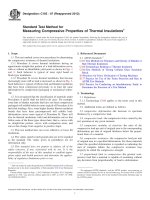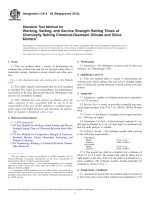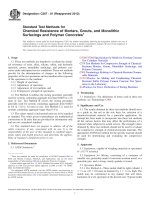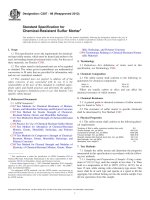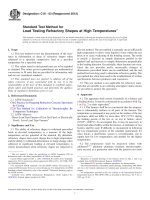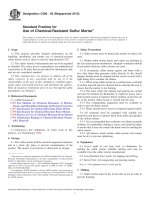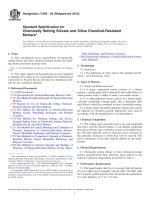Astm c 1367 06 (2012)
Bạn đang xem bản rút gọn của tài liệu. Xem và tải ngay bản đầy đủ của tài liệu tại đây (159.54 KB, 4 trang )
Designation: C1367 − 06 (Reapproved 2012)
Standard Test Method for
Dead Load Resistance of a Sealant in Elevated
Temperatures1
This standard is issued under the fixed designation C1367; the number immediately following the designation indicates the year of
original adoption or, in the case of revision, the year of last revision. A number in parentheses indicates the year of last reapproval. A
superscript epsilon (´) indicates an editorial change since the last revision or reapproval.
3.2 Definitions of Terms Specific to This Standard—
Definitions of the following terms used in this test method are
found in Terminology C717, 4.2: applicator and specified
temperature.
1. Scope
1.1 This test method covers a laboratory procedure for
determining the heat resistance of sealants. This test method is
conducted under dead load in a shear mode. This test method
was previously written to include only hot applied sealants.
4. Summary of Test Method
4.1 The sealant is placed between glass and aluminum
substrates. The specimen conditioning time is recorded. The
specimen is heated in shear mode with a weight suspended
from the specimen. The weight applied and the time that it
takes for the specimen to fail is recorded.
1.2 The values stated in SI units are to be regarded as the
standard. The values given in parentheses are provided for
information purposes only.
1.3 This standard does not purport to address all of the
safety concerns, if any, associated with its use. It is the
responsibility of the user of this standard to establish appropriate safety and health practices and determine the applicability of regulatory limitations prior to use.
1.4 The subcommittee with jurisdiction of this standard is
not aware of any similar or equivalent ISO standard.
5. Significance and Use
5.1 Sealants are generally subjected to stresses in end-use
applications. This test method measures the heat resistance of
sealants when subjected to dead load shear stresses while under
heat.
6. Apparatus
2. Referenced Documents
6.1 Sealant Applicator or Oven, capable of maintaining the
sealant within 62.8°C (65°F) of the specified temperature.
2.1 ASTM Standards:2
B209 Specification for Aluminum and Aluminum-Alloy
Sheet and Plate
C717 Terminology of Building Seals and Sealants
C1036 Specification for Flat Glass
C1375 Guide for Substrates Used in Testing Building Seals
and Sealants
6.2 Substrates:
6.2.1 Annealed glass that is 25.4 mm wide by 76.2 mm long
and 6.35 mm thick (1 in. by 3 in. by 0.25 in.). (See
Specification C1036.)
6.2.2 Aluminum alloy 5052-H32 that is 25.4 mm wide by
76.2 mm long and 0.508 mm thick (1 in. by 3 in. by 0.020 in.).
(See Specification B209.)
6.2.3 Other substrates may be used when specified (Fig. 1).
3. Terminology
3.1 Definitions—Definitions of the following terms used in
this test method are found in Terminology C717, 4.1: adhesive
failure, cohesive failure, hot-applied sealant, sealant, and
substrate.
6.3 Template, to provide 3.28-mm (1⁄8-in.) sealant thickness
(Fig. 2).
6.4 Hot Knife or Spatula.
6.5 Test Oven, capable of maintaining specified temperature
within 62.8°C (65°F). This oven must contain some apparatus
for suspending the specimens in shear mode during testing.
Automatic timing devices and recorders may be used to record
the time it takes for the test specimens to shear apart.
1
This test method is under the jurisdiction of ASTM Committee C24 on Building
Seals and Sealants and is the direct responsibility of Subcommittee C24.30 on
Adhesion.
Current edition approved Jan. 1, 2012. Published January 2012. Originally
approved in 1997. Last previous edition approved in 2006 as C1367–06. DOI:
10.1520/C1367-06R12.
2
For referenced ASTM standards, visit the ASTM website, www.astm.org, or
contact ASTM Customer Service at For Annual Book of ASTM
Standards volume information, refer to the standard’s Document Summary page on
the ASTM website.
7. Sampling
7.1 Sealant shall be free of external surface contaminants
such as talc, oil, dust, and moisture. Handling of the sealant
surfaces in contact with the substrate shall be minimized.
Copyright © ASTM International, 100 Barr Harbor Drive, PO Box C700, West Conshohocken, PA 19428-2959. United States
1
C1367 − 06 (2012)
FIG. 1 Assembly of Test Sealant on Substrates
NOTE 1—The template shall be made of a material of low thermal
conductivity, such as wood or fiberglass.
FIG. 2 Template
2
C1367 − 06 (2012)
8.1.2.5 Immediately upon removing the substrates from the
oven, place the aluminum substrate onto the sealant over the
glass substrate (Fig. 1). Using the template (Fig. 2), compress
the overlayed sealant to form a 3.18-mm (1⁄8-in.) thick overlap
(Fig. 3).
8.1.2.6 Remove excess sealant from the specimen with a hot
knife or spatula.
7.2 Condition not less than 250 g of sealant (and sufficient
portion of other components, if a multicomponent) in a closed
container for 24 h at 23 6 2°C(73.4 6 3.6°F) and 50 6 5%
relative humidity.
8. Test Specimens
8.1 Prepare five test specimens from the bulk sample by
using the applicator or oven method.
8.1.1 Applicator Method:
8.1.1.1 Clean the glass and aluminum surfaces according to
the procedures set forth in Guide C1375.
8.1.1.2 Using the appropriate die or nozzle, apply a 25.4 by
25.4-mm (1 by 1-in.) layer of sealant onto one end of the glass
surface at a thickness that when compressed will comply with
8.1.1.4. All substrates shall be at a temperature of 23 6 2°C
(73.4 6 3.6°F). Apply the sealant at the temperature specified
by the sealant manufacturer.
8.1.1.3 Immediately after sealant application, place the
aluminum substrate onto the sealant to form an overlap of 6.45
cm2(1 in.2) (Fig. 1).
8.1.1.4 Using a template (Fig. 2), compress the overlayed
sealant to form a 3.18-mm (1⁄8-in.) thick overlap (Fig. 3).
8.1.1.5 Remove excess sealant from the specimen with a hot
knife or spatula.
8.1.2 Oven Method:
8.1.2.1 Clean the glass surface according to the procedures
set forth in Guide C1375.
8.1.2.2 Place sufficient sealant onto the substrate so that
when compressed, a 6.45-cm2 (1-in.2) overlap that will comply
with 8.1.2.5 is obtained.
8.1.2.3 Clean the aluminum substrate according to the
procedures set forth in Guide C1375.
8.1.2.4 Separately place both the glass with sealant and the
overlapping aluminum into an oven and condition for 30 min
at the specified application temperature.
8.2 When the specimens are ready to handle, either because
they have cooled or have been allowed to cure at specified
conditions, cover the end of the glass substrate with several
layers of masking tape. Press the tape firmly onto the glass. Cut
small rectangular areas out of the tape so that the glass
substrate can be seen.
8.3 When the specimens are ready for testing, prepare the
aluminum end to hold a 500-g (1.10-lb) weight for the duration
of the test. This can be done by drilling or punching a hole at
the end of the aluminum substrate (centering the hole). This
hole is used for suspending the 500-g test weight. Alternatively,
the end can be punched to create a raised surface or otherwise
modified to allow suspension of the weight.
9. Conditioning
9.1 Condition all test specimens at 23 6 2°C (73.4 6 3.6°F)
and 50 6 10 % relative humidity for at least 24 h prior to
testing.
9.2 Additional conditioning may be done as specified by
mutual agreement between the purchaser and sealant manufacturer.
10. Procedure
10.1 Suspend the glass end of the specimen in the oven set
at the specified test temperature 62.8°C ( 65°F). Clips can be
attached to the glass (over the cut out rectangle) and suspended
FIG. 3 Test Assembly on Template After Compression
3
C1367 − 06 (2012)
11.1.6 Any substrate deformation during testing and the
degree of deformation,
11.1.7 Sealant application temperature,
11.1.8 Oven temperature and time of conditioning,
11.1.9 Substrates tested,
11.1.10 Substrate cleaning procedure, and
11.1.11 Any additional conditioning as allowed by 9.2.
from the top of the oven. Clamps may also be used or any
device that allows the specimens to hang vertically during the
test.
10.2 Attach a 500-g (1.10-lb) weight to the aluminum end of
the specimen. Some weights have hooks permanently attached.
Alternatively, any device that allows the weight to hang
vertically during the test may be used.
12. Precision and Bias
10.3 Close the oven door and maintain the specified test
temperature for the duration of the test.
12.1 The precision and bias of this test method are based on
data obtained from four laboratories using aluminum and glass
substrates and three sealants. Both applicator and oven methods were used and the mode of failure on all samples was
cohesive.
10.4 Record the time in minutes to shear failure of the
specimens.
10.5 Examine the shears and record the type of failure,
adhesive or cohesive, and percentage of each.
12.2 The repeatability (within a given laboratory) interval
for three materials tested by four laboratories is 4.314 min. In
future use of this test method, the difference between two test
results obtained in the same laboratory on the same material
will be expected to exceed 4.314 min only about 5 % of the
time.
NOTE 1—The oven must be at the specified test temperature before
suspending specimens. The specimens should be suspended as quickly as
possible to avoid excessive heat loss. The oven should be monitored to
ensure that the specified test temperature is maintained for the duration of
this test method.
11. Report
12.3 The reproducibility (between given laboratories) interval for three materials tested by four laboratories is 31.562 min.
In future use of this test method, the difference between two
test results obtained in a different laboratory on the same
material will be expected to exceed 31.562 min only about 5 %
of the time.
11.1 Report the following information:
11.1.1 Sealant name and any other identifying
characteristics,
11.1.2 Equipment used to apply the sealant,
11.1.3 Specified test temperature and load applied,
11.1.4 Average time to failure in minutes,
11.1.5 Type of failure, adhesive or cohesive, and percentage
of each,
13. Keywords
13.1 dead load shear; heat resistance; time to failure
ASTM International takes no position respecting the validity of any patent rights asserted in connection with any item mentioned
in this standard. Users of this standard are expressly advised that determination of the validity of any such patent rights, and the risk
of infringement of such rights, are entirely their own responsibility.
This standard is subject to revision at any time by the responsible technical committee and must be reviewed every five years and
if not revised, either reapproved or withdrawn. Your comments are invited either for revision of this standard or for additional standards
and should be addressed to ASTM International Headquarters. Your comments will receive careful consideration at a meeting of the
responsible technical committee, which you may attend. If you feel that your comments have not received a fair hearing you should
make your views known to the ASTM Committee on Standards, at the address shown below.
This standard is copyrighted by ASTM International, 100 Barr Harbor Drive, PO Box C700, West Conshohocken, PA 19428-2959,
United States. Individual reprints (single or multiple copies) of this standard may be obtained by contacting ASTM at the above
address or at 610-832-9585 (phone), 610-832-9555 (fax), or (e-mail); or through the ASTM website
(www.astm.org). Permission rights to photocopy the standard may also be secured from the Copyright Clearance Center, 222
Rosewood Drive, Danvers, MA 01923, Tel: (978) 646-2600; />
4

